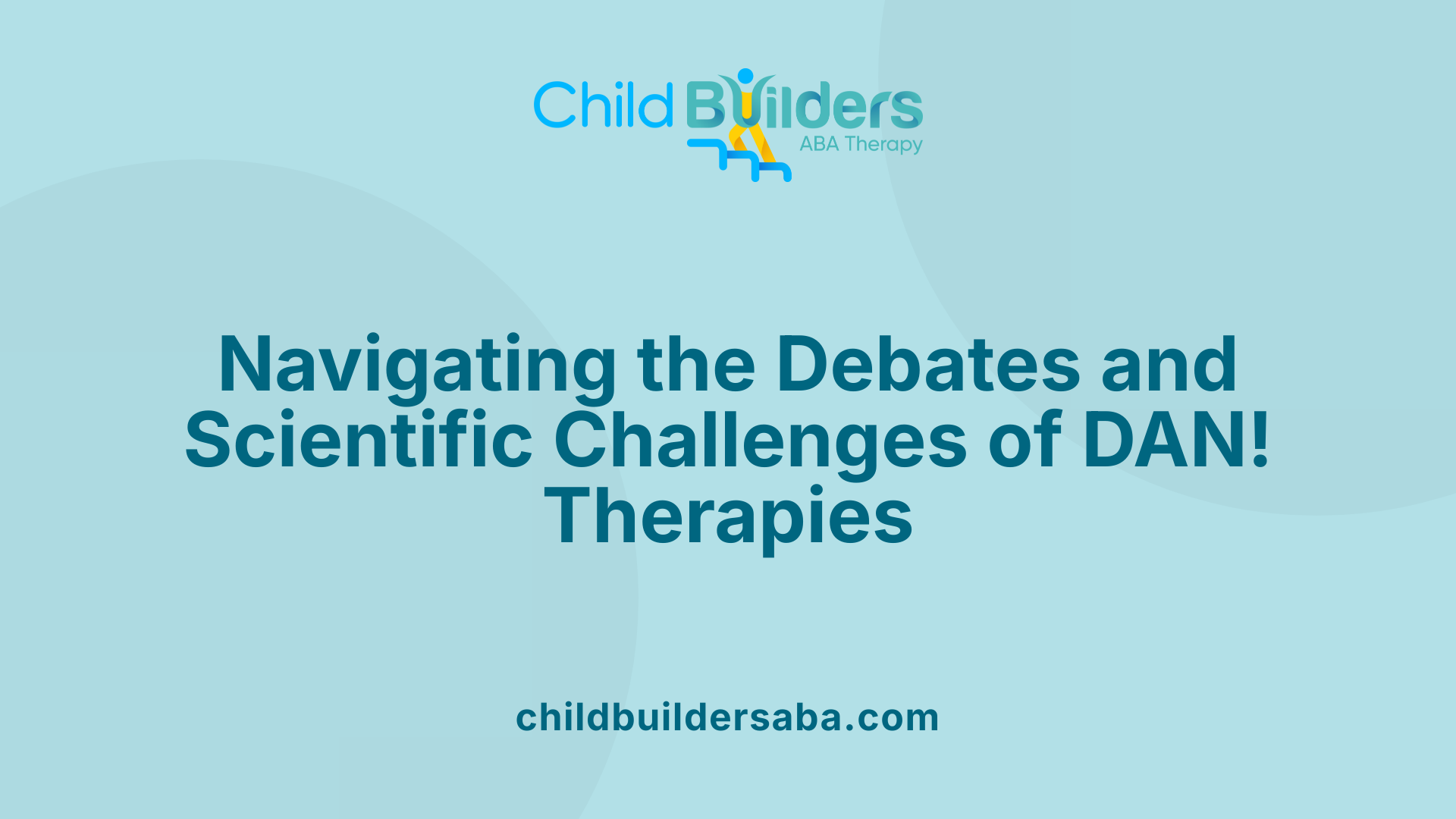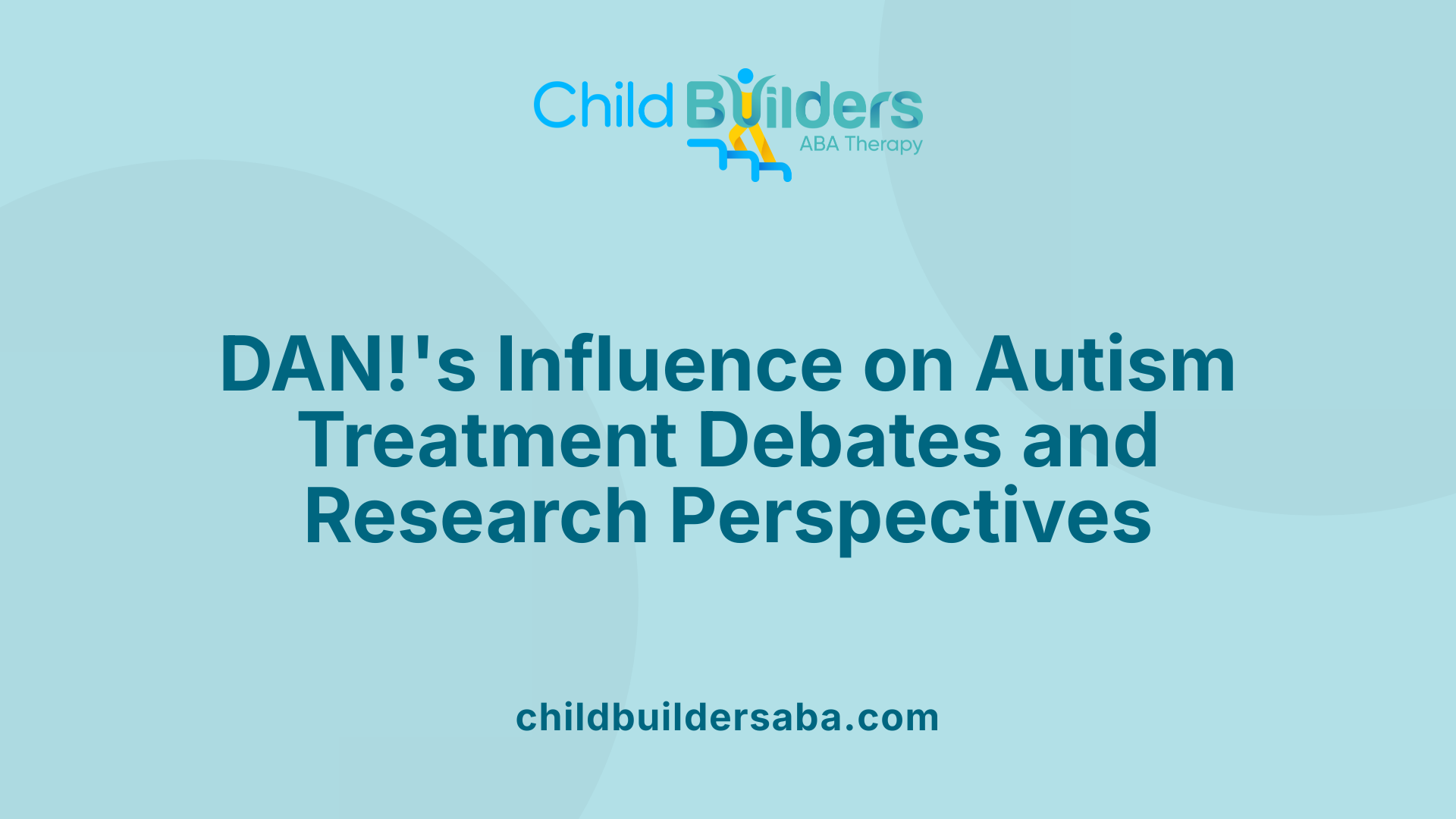What Is Defeat Autism Now?

Understanding the Origins and Intentions of DAN!
The 'Defeat Autism Now!' (DAN!) movement emerged in 1995 through a collaboration of members within the Autism Research Institute. It advocates for a comprehensive approach to diagnose and treat autism spectrum disorder (ASD) that extends beyond conventional methods. This movement emphasizes biomedical interventions, pushing for treatments that target presumed underlying causes of autism, often encompassing special diets, supplements, and detoxification protocols. While its dedicated community aims to improve the lives of those with autism, DAN! has sparked significant debate within the medical community, especially regarding the scientific validation and safety of its recommended interventions.
The Foundations and Principles of DAN!

Origin of DAN!
The Defeat Autism Now! (DAN!) project was initiated in 1995 as a collaborative effort involving members of the Autism Research Institute. It emerged out of a desire to explore alternative approaches to diagnosing and treating autism. The movement gained traction among many families seeking additional options beyond conventional medicine.
DAN! advocates for a comprehensive and specific protocol designed to address the multifaceted nature of autism. Its focus is on identifying underlying biomedical factors that may contribute to the condition and applying targeted treatments accordingly.
Advocated protocols for diagnosis and treatment
The DAN! approach emphasizes extensive screening to uncover potential biomedical contributors to autism. This might include testing for nutritional deficiencies, detoxification status, and immune system functioning.
The protocols often involve dietary modifications, supplementation, detoxification strategies, and sometimes biomedical interventions aimed at improving neurological function. These approaches are integrated into the overall treatment plan, which is individualized for each child.
While the DAN! protocols provide a structured pathway, scientific validation of these methods remains a subject of ongoing debate within the medical community. Evidence supporting these treatments is often described as incomplete and varies widely among different interventions.
Promoted biomedical treatments
DAN! advocates promote a variety of biomedical treatments that aim to address underlying health issues believed to influence autism symptoms. These may include:
- Nutritional supplementation to correct deficiencies
- Detoxification procedures to reduce toxic burdens
- Immune system modulation treatments
- Addressing gastrointestinal health issues
Parents are encouraged to discuss all proposed investigations and therapies with their primary care providers before beginning treatment. This collaborative approach helps to ensure that interventions are both safe and potentially beneficial.
Healthcare professionals, including clinicians, are advised to maintain open lines of communication and work alongside families and educational specialists. Such collaboration ensures that the child's needs are comprehensively addressed, and effective treatment options are identified.
Recognizing diverse perspectives
Parents often have differing beliefs about the effectiveness and risks of various autism treatments. Therefore, transparent discussions between families and healthcare providers are vital. Understanding each family's perspective allows for a personalized approach, fostering trust and shared decision-making.
While DAN! promotes certain biomedical interventions, it is essential for families and clinicians to evaluate the scientific support for each treatment. Informed discussions and careful planning help ensure safety and optimize outcomes for children with autism.
The Controversies Surrounding DAN!

Scientific support and validation issues
The Defeat Autism Now! (DAN!) project emerged in 1995 as a collaborative effort led by members of the Autism Research Institute. It advocates for a comprehensive protocol aimed at diagnosing and treating autism, often through biomedical interventions.
However, many of these treatments lack rigorous scientific validation. The evidence supporting these interventions is often inconsistent and not uniformly accepted by the broader medical community. This disparity is highlighted by the fact that mainstream organizations, such as the American Academy of Pediatrics, note that support for many DAN! protocols remains incomplete and outdated.
Parents and caregivers are encouraged to discuss all proposed treatments and investigations with their primary care providers to ensure safety and appropriateness. Clinicians are also advised to maintain open communication to find the most effective and safe strategies for each individual.
Debates within the medical community
The role of DAN! in autism treatment continues to generate debate. Critics point out that many interventions promoted by DAN! lack scientific validation. They warn that these unproven and sometimes invasive treatments could pose health risks, including nutritional imbalances or physical harm.
Medical professionals emphasize the importance of evidence-based practices. They caution against reliance on therapies that have not been adequately tested, as these could delay access to proven therapies that could improve outcomes for individuals with autism.
Furthermore, there is a recognition that families’ beliefs and concerns vary. Open dialogue is essential, with clinicians and families working together to decide on treatments that align with safety, evidence, and personal values.
Risks associated with biomedical treatments
Biomedical interventions promoted by DAN! sometimes involve invasive procedures, dietary restrictions, or supplement protocols. Although intended to alleviate symptoms or improve quality of life, such approaches may carry health risks.
Unvalidated treatments can also divert families from evidence-based options, potentially delaying the implementation of proven therapies like behavioral interventions, speech therapy, and educational support.
Overall, the debate reflects a broader tension between seeking innovative treatments and safeguarding children’s health through scientifically supported care.
| Aspect | Perspective | Additional Details |
|---|---|---|
| Scientific validation | Lacking or incomplete for many DAN! therapies | Many interventions have not been rigorously tested in clinical trials |
| Medical community stance | Cautious and critical | Urge evidence-based practices and risks awareness |
| Family involvement | Varied | Open communication with healthcare providers is vital |
| Treatment risks | Potential harm | Invasive procedures and nutritional risks |
Addressing these controversies requires ongoing research, open communication, and a shared focus on safe, effective, and scientifically supported treatments for autism.
Historical Development and Current Status of DAN!

Evolution from inception to present day
The Defeat Autism Now! (DAN!) project was launched in 1995 through a collaboration between members of the Autism Research Institute. Its goal was to establish a comprehensive protocol for diagnosing and treating autism, emphasizing biomedical interventions that aimed to address potential underlying causes of the disorder.
Over the years, DAN! has developed a reputation for advocating specific treatment strategies that often involve dietary changes, nutritional supplements, detoxification protocols, and other biomedical therapies. The movement grew rapidly, attracting many families seeking alternative approaches outside traditional behavioral and psychiatric treatments.
Despite its popularity among certain groups, the scientific community has expressed skepticism regarding DAN!'s methods. As research progressed, the validation for many of its proposed interventions remained limited or inconsistent, leading to ongoing debate about their efficacy.
Involvement in autism research and treatment discussions
DAN! has played a significant role in shaping discussions on autism treatment options, especially among families and practitioners favoring biomedical approaches. The movement has historically positioned itself as a leader in exploring possible underlying causes of autism, often promoting treatments aimed at biochemical imbalances or toxic exposures.
However, this focus has sometimes been at odds with mainstream medical consensus. Many of the interventions promoted by DAN! are considered experimental or lacking sufficient scientific support, contributing to a contentious relationship with the broader healthcare community.
Families are encouraged to consult with primary care providers before pursuing treatments recommended by DAN!. Open communication between clinicians, families, and educational professionals is vital to ensure that interventions are appropriate and safe.
Current status of the movement
Today, DAN! remains influential among a subset of parents and practitioners advocating for biomedical options. While its protocols are not universally endorsed by the scientific community, it continues to advocate for further research and personalized treatment approaches.
The movement has also adapted, emphasizing collaboration and the importance of evidence-based practices. Families are urged to discuss all investigations and therapies with healthcare professionals to make informed decisions.
Furthermore, ongoing research into new treatments like Balovaptan, CM-AT, and experimental drugs suggests a horizon of promising developments in autism care. Despite advances, there is no established cure for autism, but organizations such as Cure Autism Now actively invest in research aimed at prevention, treatment, and potentially a cure.
In the broader landscape, DAN! remains a notable, although controversial, voice in autism treatment debates, highlighting the need for continued investigation into biomedical interventions.
Role and Impact of DAN! in Autism Evaluation and Treatment Discussion

Its influence in autism treatment debates
The Defeat Autism Now! (DAN!) movement emerged in 1995 from a collaboration among members of the Autism Research Institute. It promotes a biomedical approach to autism, advocating for specific protocols aimed at diagnosing and treating the condition. While some families and practitioners see these interventions as promising, DAN! has become a focal point of controversy within the medical community.
DAN!'s emphasis on alternative treatments—including dietary changes, supplements, and other non-standard therapies—has influenced public perception and treatment options for autism. However, the scientific validation for many of these interventions remains incomplete, leading to ongoing debates regarding their safety and efficacy.
Critics argue that the lack of rigorous scientific support raises concerns over the potential risks and unproven nature of some DAN! recommended therapies. Nevertheless, the movement has undoubtedly shaped conversations around autism treatments, highlighting the need for more research and balanced approaches.
Relationship with research and assessment
DAN! advocates for a distinctive approach to diagnosis and treatment of autism, emphasizing comprehensive protocols that go beyond standard practices. This has led to the development of specialized assessment tools and interventions aimed at addressing perceived underlying causes.
Despite its influence, the scientific backing for these methods is often regarded as disparate and incomplete compared to mainstream recommendations. For instance, organizations like the American Academy of Pediatrics emphasize evidence-based practices. In contrast, DAN! promotes strategies that sometimes lack broad scientific consensus.
While DAN! has contributed to raising awareness about biomedical and alternative options, concerns about the scientific rigor of these interventions persist. This divergence highlights the need for ongoing research to validate effective treatments and ensure patient safety.
Communication and collaboration with families and professionals
Effective management of autism benefits from open lines of communication among clinicians, families, and educational professionals. Since many parents have varying beliefs about what treatments are effective or safe, it is crucial to foster dialogue that respects these perspectives.
Clinicians are encouraged to actively collaborate with families and educators to identify interventions that are both appropriate and safe. This teamwork ensures that treatment plans are individualized and consider the child's unique needs.
Maintaining transparency about the potential benefits and risks of proposed treatments helps build trust and facilitates better decision-making. Ultimately, fostering an environment of open, ongoing communication supports the goal of providing the best possible support for individuals with autism.
Below is a summary table contrasting different aspects of the discussion:
| Aspect | Details | Additional Notes |
|---|---|---|
| Origin | Founded in 1995 through collaboration with Autism Research Institute | Focused on biomedical treatments |
| Treatment Approach | Emphasizes dietary changes, supplements, and alternative therapies | Lacks full scientific validation |
| Scientific Community's View | Generally calls for more rigorous research and validation | Concerns over safety and efficacy |
| Role in Autism Trends | Influential in shaping public opinion and treatment preferences | Sparks debate on effectiveness and safety |
| Importance of Communication | Essential for personalized, safe treatment planning | Requires transparency and respect for beliefs |
| Relationship with Mainstream Medicine | Sometimes at odds due to differing views on scientific support | Calls for integration and robust research efforts |
This overview illustrates how the DAN! movement continues to impact discussions about autism treatment, balancing advocacy, controversy, and the need for evidence-based practice.
Looking Ahead: The Future of Autism Treatment and Advocacy
The landscape of autism treatment continues to evolve, with groundbreaking pharmacological research promising new possibilities alongside well-established behavioral therapies. The role of movements like DAN! remains controversial, emphasizing the need for rigorous scientific validation and open dialogue among clinicians, families, and researchers. Moving forward, a balanced, evidence-based approach that respects individual differences and encourages collaboration will be crucial in shaping effective and safe autism interventions, ensuring that progress brings tangible benefits to those with autism and their families.
References
- Use of complementary and alternative treatments for children with ...
- High-Functioning Autism: Asperger's, Autism Levels & More
- What to Know About Autism Spectrum Disorder (ASD) - Healthline
- Types of Autism: Terminology That's No Longer Used Today
- Autism in Adults: Diagnosis, Treatment, and Resources - Healthline
- Autism in Women: Symptoms, Causes, Diagnosis, and Treatment
- The Heritability of Autism Spectrum Disorder - PMC
- The Heritability of Autism Spectrum Disorder - PubMed
- How Heritability Affects Autism Spectrum Disorder - SkyCare ABA



.jpg)

































































































